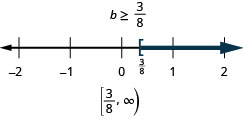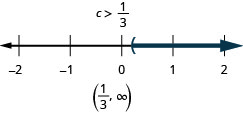Chapter 2 Review Exercises
( \newcommand{\kernel}{\mathrm{null}\,}\)
Chapter 2 Review Exercises
Solve Equations using the Subtraction and Addition Properties of Equality
Verify a Solution of an Equation
In the following exercises, determine whether each number is a solution to the equation.
10x−1=5x;x=15
w+2=58;w=38
- Answer
-
no
−12n+5=8n;n=−54
6a−3=−7a,a=313
- Answer
-
yes
Solve Equations using the Subtraction and Addition Properties of Equality
In the following exercises, solve each equation using the Subtraction Property of Equality.
x+7=19
y+2=−6
- Answer
-
y=−8
a+13=53
n+3.6=5.1
- Answer
-
n=1.5
In the following exercises, solve each equation using the Addition Property of Equality.
u−7=10
x−9=−4
- Answer
-
x=5
c−311=911
p−4.8=14
- Answer
-
p=18.8
In the following exercises, solve each equation.
n−12=32
y+16=−9
- Answer
-
y=−25
f+23=4
d−3.9=8.2
- Answer
-
d=12.1
Solve Equations That Require Simplification
In the following exercises, solve each equation.
y+8−15=−3
7x+10−6x+3=5
- Answer
-
x=−8
6(n−1)−5n=−14
8(3p+5)−23(p−1)=35
- Answer
-
p=−28
Translate to an Equation and Solve
In the following exercises, translate each English sentence into an algebraic equation and then solve it.
The sum of −6 and m is 25
Four less than n is 13
- Answer
-
n−4=13;n=17
Translate and Solve Applications
In the following exercises, translate into an algebraic equation and solve.
Rochelle’s daughter is 11 years old. Her son is 3 years younger. How old is her son?
Tan weighs 146 pounds. Minh weighs 15 pounds more than Tan. How much does Minh weigh?
- Answer
-
161 pounds
Peter paid $9.75 to go to the movies, which was $46.25 less than he paid to go to a concert. How much did he pay for the concert?
Elissa earned $152.84 this week, which was $2..65 more than she earned last week. How much did she earn last week?
- Answer
-
$131.19
Solve Equations using the Division and Multiplication Properties of Equality
Solve Equations Using the Division and Multiplication Properties of Equality
In the following exercises, solve each equation using the division and multiplication properties of equality and check the solution.
8x=72
13a=−65
- Answer
-
a=−5
0.25p=5.25
−y=4
- Answer
-
y=−4
n6=18
y−10=30
- Answer
-
y=−300
36=34x
58u=1516
- Answer
-
u=32
−18m=−72
c9=36
- Answer
-
c=324
0.45x=6.75
1112=23y
- Answer
-
y=118
Solve Equations That Require Simplification
In the following exercises, solve each equation requiring simplification.
5r−3r+9r=35−2
24x+8x−11x=−7−14
- Answer
-
x=−1
1112n−56n=9−5
−9(d−2)−15=−24
- Answer
-
d=3
Translate to an Equation and Solve
In the following exercises, translate to an equation and then solve.
143 is the product of −11 and y
The quotient of b and and 9 is −27
- Answer
-
b9=−27;b=−243
The sum of q and one-fourth is one.
The difference of s and one-twelfth is one fourth.
- Answer
-
s−112=14;s=13
Translate and Solve Applications
In the following exercises, translate into an equation and solve.
Ray paid $21 for 12 tickets at the county fair. What was the price of each ticket?
Janet gets paid $24 per hour. She heard that this is 34 of what Adam is paid. How much is Adam paid per hour?
- Answer
-
$32
Solve Equations with Variables and Constants on Both Sides
Solve an Equation with Constants on Both Sides
In the following exercises, solve the following equations with constants on both sides.
8p+7=47
10w−5=65
- Answer
-
w=7
3x+19=−47
32=−4−9n
- Answer
-
n=−4
Solve an Equation with Variables on Both Sides
In the following exercises, solve the following equations with variables on both sides.
7y=6y−13
5a+21=2a
- Answer
-
a=−7
k=−6k−35
4x−38=3x
- Answer
-
x=38
Solve an Equation with Variables and Constants on Both Sides
In the following exercises, solve the following equations with variables and constants on both sides.
12x−9=3x+45
5n−20=−7n−80
- Answer
-
n=−5
4u+16=−19−u
58c−4=38c+4
- Answer
-
c=32
Use a General Strategy for Solving Linear Equations
Solve Equations Using the General Strategy for Solving Linear Equations
In the following exercises, solve each linear equation.
6(x+6)=24
9(2p−5)=72
- Answer
-
p=132
−(s+4)=18
8+3(n−9)=17
- Answer
-
n=12
23−3(y−7)=8
13(6m+21)=m−7
- Answer
-
m=−14
4(3.5y+0.25)=365
0.25(q−8)=0.1(q+7)
- Answer
-
q=18
8(r−2)=6(r+10)
5+7(2−5x)=2(9x+1)−(13x−57)
- Answer
-
x=−1
(9n+5)−(3n−7)=20−(4n−2)
2[−16+5(8k−6)]=8(3−4k)−32
- Answer
-
k=34
Classify Equations
In the following exercises, classify each equation as a conditional equation, an identity, or a contradiction and then state the solution.
17y−3(4−2y)=11(y−1)+12y−1
9u+32=15(u−4)−3(2u+21)
- Answer
-
contradiction; no solution
−8(7m+4)=−6(8m+9)
21(c−1)−19(c+1)=2(c−20)
- Answer
-
identity; all real numbers
Solve Equations with Fractions and Decimals
Solve Equations with Fraction Coefficients
In the following exercises, solve each equation with fraction coefficients.
25n−110=710
13x+15x=8
- Answer
-
x=15
34a−13=12a−56
12(k−3)=13(k+16)
- Answer
-
k=41
3x−25=3x+48
5y−13+4=−8y+46
- Answer
-
y=−1
Solve Equations with Decimal Coefficients
In the following exercises, solve each equation with decimal coefficients.
0.8x−0.3=0.7x+0.2
0.36u+2.55=0.41u+6.8
- Answer
-
u=−85
0.6p−1.9=0.78p+1.7
0.6p−1.9=0.78p+1.7
- Answer
-
d=−20
Solve a Formula for a Specific Variable
Use the Distance, Rate, and Time Formula
In the following exercises, solve.
Natalie drove for 712 hours at 60 miles per hour. How much distance did she travel?
Mallory is taking the bus from St. Louis to Chicago. The distance is 300 miles and the bus travels at a steady rate of 60 miles per hour. How long will the bus ride be?
- Answer
-
5 hours
Aaron’s friend drove him from Buffalo to Cleveland. The distance is 187 miles and the trip took 2.75 hours. How fast was Aaron’s friend driving?
Link rode his bike at a steady rate of 15 miles per hour for 212 hours. How much distance did he travel?
- Answer
-
37.5 miles
Solve a Formula for a Specific Variable
In the following exercises, solve.
Use the formula. d=rt to solve for t
- when d=510 and r=60
- in general
Use the formula. d=rt to solve for r
- when when d=451 and t=5.5
- in general
- Answer
-
- r=82mph
- r=Dt
Use the formula A=12bh to solve for b
- when A=390 and h=26
- in general
Use the formula A=12bh to solve for b
- when A=153 and b=18
- in general
- Answer
-
- h=17
- h=2Ab
Use the formula I=Prt to solve for the principal, P for
- I=$2,501,r=4.1%, t=5 years
- in general
Solve the formula 4x+3y=6 for y
- when x=−2
- in general
- Answer
-
ⓐ y=143 ⓑ y=6−4x3
Solve 180=a+b+c for c
Solve the formula V=LWH for H
- Answer
-
H=VLW
Solve Linear Inequalities
Graph Inequalities on the Number Line
In the following exercises, graph each inequality on the number line.
- x≤4
- x>−2
- x<1
- x>0
- x<−3
- x≥−1
- Answer
-
In the following exercises, graph each inequality on the number line and write in interval notation.
- x<−1
- x≥−2.5
- x≤54
- x>2
- x≤−1.5
- x≥53
- Answer
-
Solve Inequalities using the Subtraction and Addition Properties of Inequality
In the following exercises, solve each inequality, graph the solution on the number line, and write the solution in interval notation.
n−12≤23
m+14≤56
- Answer
-

a+23≥712
b−78≥−12
- Answer
-

Solve Inequalities using the Division and Multiplication Properties of Inequality
In the following exercises, solve each inequality, graph the solution on the number line, and write the solution in interval notation.
9x>54
−12d≤108
- Answer
-

52j<−60
q−2≥−24
- Answer
-

Solve Inequalities That Require Simplification
In the following exercises, solve each inequality, graph the solution on the number line, and write the solution in interval notation.
6p>15p−30
9h−7(h−1)≤4h−23
- Answer
-

5n−15(4−n)<10(n−6)+10n
38a−112a>512a+34
- Answer
-

Translate to an Inequality and Solve
In the following exercises, translate and solve. Then write the solution in interval notation and graph on the number line.
Five more than z is at most 19.
Three less than c is at least 360.
- Answer
-

Nine times n exceeds 42.
Negative two times a is no more than 8.
- Answer
-

Everyday Math
Describe how you have used two topics from this chapter in your life outside of your math class during the past month.
Chapter 2 Practice Test
Determine whether each number is a solution to the equation 6x−3=x+20
- 5
- 235
- Answer
-
- no
- yes
In the following exercises, solve each equation.
n−23=14
92c=144
- Answer
-
c=32
4y−8=16
−8x−15+9x−1=−21
- Answer
-
x=−5
−15a=120
23x=6
- Answer
-
x=9
x−3.8=8.2
10y=−5y−60
- Answer
-
y=−4
8n−2=6n−12
9m−2−4m−m=42−8
- Answer
-
m=9
−5(2x−1)=45
−(d−9)=23
- Answer
-
d=−14
14(12m−28)=6−2(3m−1)
2(6x−5)−8=−22
- Answer
-
x=−13
8(3a−5)−7(4a−3)=20−3a
14p−13=12
- Answer
-
p=103
0.1d+0.25(d+8)=4.1
14n−3(4n+5)=−9+2(n−8)
- Answer
-
contradiction; no solution
9(3u−2)−4[6−8(u−1)]=3(u−2)
Solve the formula x−2y=5 for y
- when x=−3
- in general
- Answer
-
- y=4
- y=5−x2
In the following exercises, graph on the number line and write in interval notation.
x≥−3.5
x<114
- Answer
-

In the following exercises,, solve each inequality, graph the solution on the number line, and write the solution in interval notation.
8k≥5k−120
3c−10(c−2)<5c+16
- Answer
-

In the following exercises, translate to an equation or inequality and solve.
4 less than twice x is 16.
Fifteen more than n is at least 48.
- Answer
-
n+15≥48;n≥33
Samuel paid $25.82 for gas this week, which was $3.47 less than he paid last week. How much had he paid last week?
Jenna bought a coat on sale for $120, which was 23 of the original price. What was the original price of the coat?
- Answer
-
120=23p; The original price was $180
Sean took the bus from Seattle to Boise, a distance of 506 miles. If the trip took 723 hours, what was the speed of the bus?








